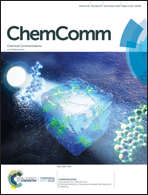Unravelling a general mechanism of converting ionic B/N complexes into neutral B/N analogues of alkanes: Hδ+⋯Hδ– dihydrogen bonding assisted dehydrogenation†
Abstract
Long-sought mechanisms for the conversion of diammoniate of diborane ([NH3BH2NH3]+[BH4]−) into NH3BH3 and [NH2BH2]n as well as ammonium aminodiborane ([NH4]+[BH3NH2BH3]−) into a butane analogue, NH3BH2NH2BH3, have been elucidated on the basis of extensive experimental and theoretical studies. The [NH4]+ ammonium cation and the (η2-H2)BH2R moiety are found to be critical in B/N chain expansion.



 Please wait while we load your content...
Please wait while we load your content...